Timeless Music, Elegant Performance
Bringing harmony to life, one note at a time
Timeless Music, Elegant Performance
Bringing harmony to life, one note at a time
📍 Margaret Klem
San Clemente
Harpist in San Clemente – Creating refined, timeless music inspired by the beauty and spirit of the coast. Specializing in classical and contemporary harp performances, with versatile programs tailored for weddings, private events, and special occasions
📍 Margaret Klem
San Clemente
Harpist in San Clemente – Creating refined, timeless music inspired by the beauty and spirit of the coast. Specializing in classical and contemporary harp performances, with versatile programs tailored for weddings, private events, and special occasions
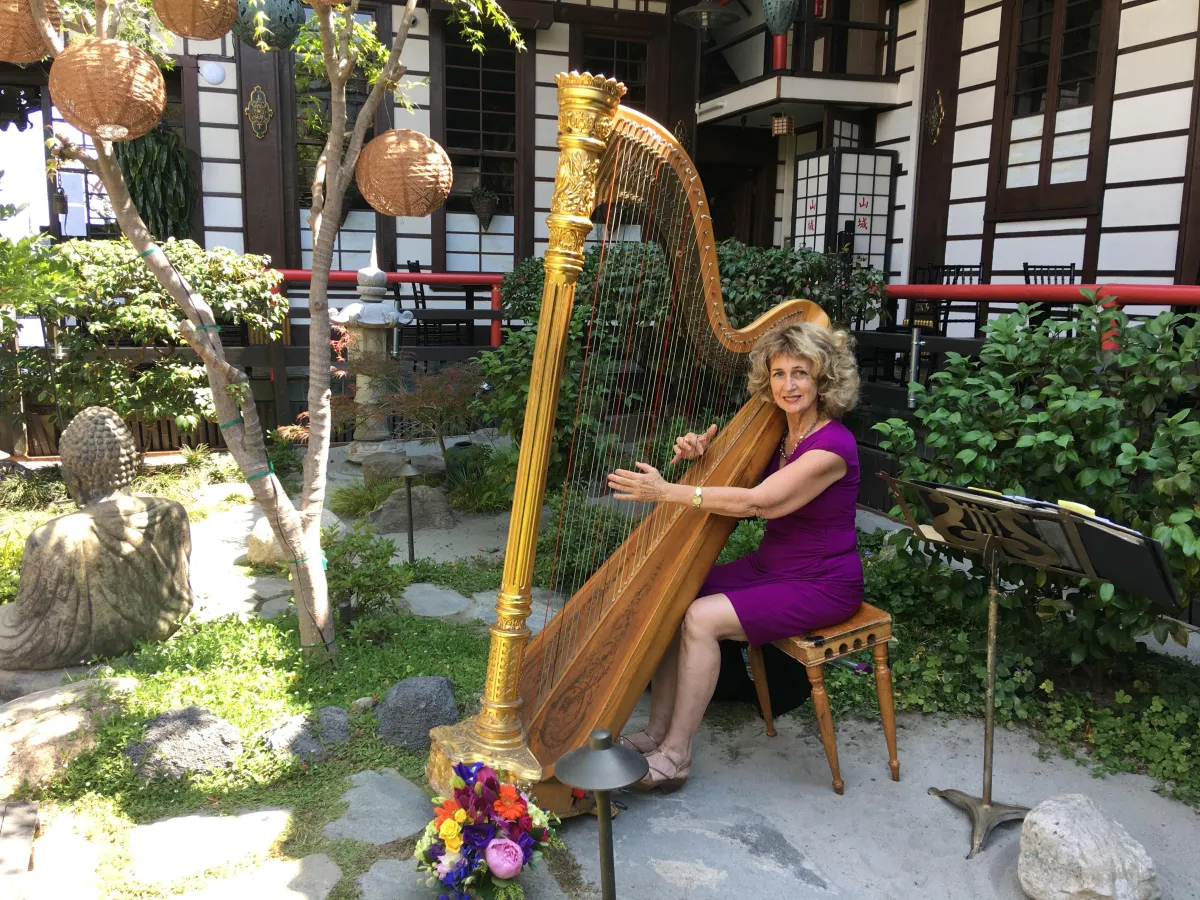
The harp — timeless grace in sound.
The harp — timeless grace in sound.
Being a harpist is more than playing an instrument—it is the art of weaving elegance, emotion, and timeless beauty into sound. The harp, with its shimmering strings and graceful presence, creates an atmosphere unlike any other, transforming both intimate gatherings and grand occasions into truly memorable experiences. As a harpist, I bring not only technical skill but also a deep passion for the instrument’s history and expressive power, drawing inspiration from both classical traditions and modern interpretations. Every performance is an opportunity to share the harp’s unique voice, whether it is the delicate whisper of a single note or the sweeping resonance of a full arpeggio. My goal is always to craft music that elevates the moment—whether it is a wedding ceremony filled with love, a private event in need of ambiance, or a concert hall where every listener can be transported by the harp’s ethereal sound. To be a harpist is to be both a storyteller and a guide, inviting audiences into a world of harmony, grace, and emotional connection through music.
.
Being a harpist is more than playing an instrument—it is the art of weaving elegance, emotion, and timeless beauty into sound. The harp, with its shimmering strings and graceful presence, creates an atmosphere unlike any other, transforming both intimate gatherings and grand occasions into truly memorable experiences. As a harpist, I bring not only technical skill but also a deep passion for the instrument’s history and expressive power, drawing inspiration from both classical traditions and modern interpretations. Every performance is an opportunity to share the harp’s unique voice, whether it is the delicate whisper of a single note or the sweeping resonance of a full arpeggio. My goal is always to craft music that elevates the moment—whether it is a wedding ceremony filled with love, a private event in need of ambiance, or a concert hall where every listener can be transported by the harp’s ethereal sound. To be a harpist is to be both a storyteller and a guide, inviting audiences into a world of harmony, grace, and emotional connection through music.
How to Book and Connect – Outside of Performances
For unforgettable harp music, contact Margaret at (714) 809-4277 or [email protected]
Market Hours
🗓️ Every Second Saturday of the Month
🕖 10:00 AM – 2:00 PM
LOCATION: Old Town San Clemente, 111 W. Avenida Palizada, San Clemente, CA 92672
The Story Behind the Strings
Margaret Klemm has always been fascinated and inspired by the power of music!
Beside singing, her first instrument was the piano, which was her constant companion through her youth. Upon entering the University of Illinois a rare opportunity presented itself to add study of the harp to her music making. And what a pivotal moment that became. Through a program that afforded her the opportunity to teach school in Austria, Margaret also played harp at the Volksoper opera house in Vienna. Summer travel took her to Holland and France for further harp seminars before returning to the US and getting her Masters Degree in Harp at UA in Arizona.
While out West, it was a hop, ship and a jump from Arizona to California so Margaret explored the music scene here in Orange County. There were many opportunities to make music in Southern California. Margaret was the harpist for twenty years at the Crystal Cathedral in Garden Grove. She’s played in many orchestras and freelanced, Margaret was in demand. She also entertained in the fine dining restaurant of JW’s at the Anaheim Marriott hotel upon its opening, entertaining 5 nights per week for over 10 years! She loved traveling to Europe often and was invited to play harp concerts three years in a row in Heidelberg, Germany.
This was during the heyday of the annual Bach Week, a Festival honoring the music of J S Bach, She was a featured artist in this Bach Festival Week at the historic Heilig Geist Church and also performed in the cities of Mannheim and Wörms.
Margaret has the heart of a teacher She taught elementary music in various districts in Orange County for many years. She loves teaching private lessons on harp, piano and voice. Did I mention that Margaret was also Soprano soloist for 4 years at St. John’s Lutheran Church in the city of Orange. This was an annual series of Bach Cantatas. Of course these cantatas were sung in German!
Margaret is available to play for your special events, from weddings, to holiday parties, whatever occasion you have including a Celebration of Life. She welcomes new students and loves to foster their lifelong love of music. Margaret plays with deep feeling and loves to share the joy of the timeless art of music with all the people she meets!
How to Book and Connect – Outside of Performances
For unforgettable harp music, contact Margaret at (714) 809-4277 or [email protected]
VISIT US AT THE: Old Town Market
🗓️ Every Second Saturday of the Month
🕖 10:00 AM – 2:00 PM
LOCATION: Old Town San Clemente, 111 W. Avenida Palizada, San Clemente, CA 92672
Creating moments of beauty, one string at a time.
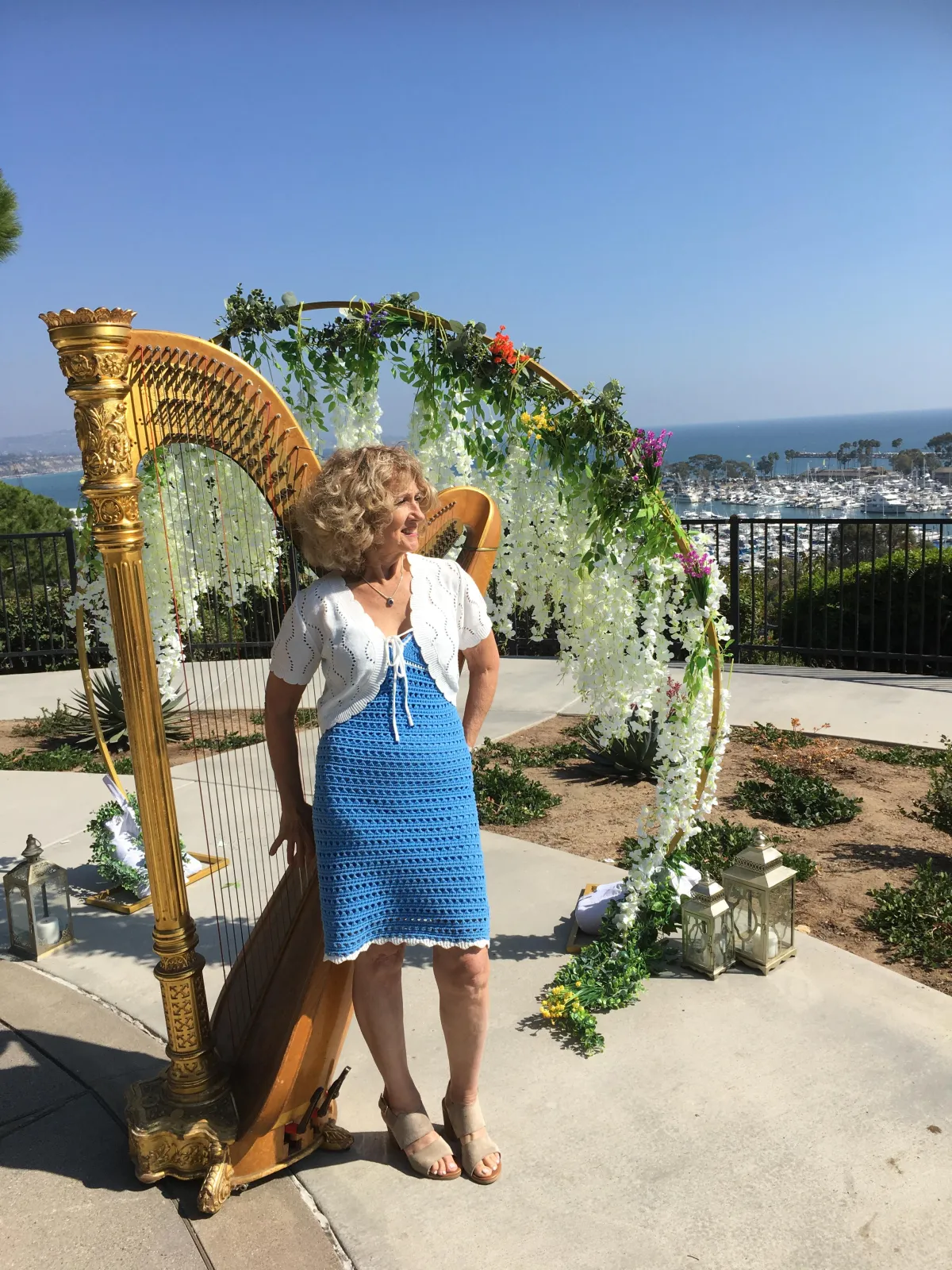
Structure and Mechanics
A harp typically consists of three main parts: the soundboard, the neck, and the pillar. Strings run vertically along the soundboard and vary in length, producing different pitches when plucked. Modern concert harps can include pedals or levers that alter string tension, allowing the performer to play in multiple keys. The instrument’s design enables it to produce both melody and harmony simultaneously.
Sound and Characteristics
The harp is valued for its distinctive tonal quality, often described as warm, shimmering, and ethereal. Its resonance allows for both delicate, flowing passages and strong, rhythmic accompaniments. The instrument is used to create atmospheres ranging from meditative to celebratory, making it popular in both solo and ensemble settings.
Musical Versatility
While strongly associated with classical and folk music, the harp is capable of performing a wide repertoire, including jazz, popular, and contemporary works. Harpists adapt arrangements of well-known pieces, offering fresh interpretations across genres. Its adaptability has contributed to its presence in weddings, concerts, and ceremonial occasions.
Cultural Significance
The harp has long held symbolic importance in art, literature, and national identity. It is the national emblem of Ireland and appears in numerous cultural traditions worldwide. Beyond symbolism, it remains a sought-after instrument for creating ambiance, beauty, and emotional resonance at both public and private events.
Historical and Cultural Significance
The harp has been a symbol of art, culture, and spirituality across civilizations:
In ancient Egypt, harps were associated with ritual and court life.
In Celtic traditions, the harp was a central instrument of bards, symbolizing storytelling and heritage.
In Ireland, the harp remains a national emblem, appearing on coins, seals, and the presidential flag.
In religious art, angels are frequently depicted playing harps, reinforcing its association with the divine.
Contemporary Use
Today, the harp is performed in a variety of contexts, including:
Weddings and Private Events: Providing elegant, live music to mark special occasions.
Orchestral and Chamber Music: Serving as both a solo and ensemble instrument in classical compositions.
Music Therapy: Used in healing and wellness settings due to its calming, meditative sound.
Education: Studied at conservatories, universities, and private studios around the world
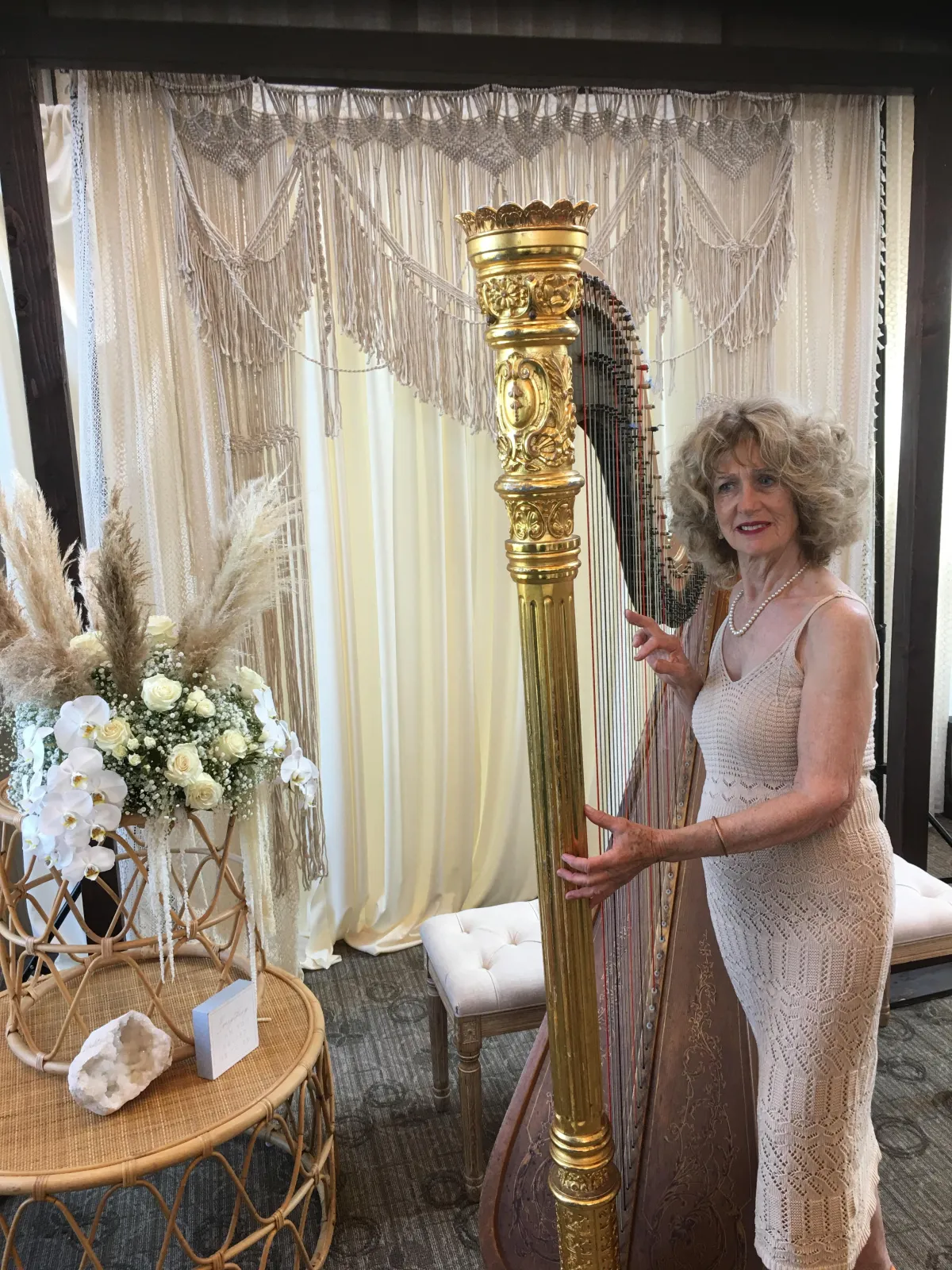
Components of the Harp
The harp, one of the world’s oldest and most enduring string instruments, is defined by its distinctive triangular frame and unique method of sound production. Modern harps—whether pedal, lever, or folk varieties—are built around three essential structural elements: the soundboard, the neck, and the pillar. Each component has a specific role in maintaining the instrument’s integrity and shaping its characteristic sound.
Soundboard
The soundboard is the large, resonating surface located at the base of the harp’s triangular frame. Typically constructed from carefully selected spruce wood, the soundboard amplifies the vibrations of the strings when they are plucked.
Construction and Material: Spruce is favored because of its light weight and strong resonating qualities, though some folk harps may use alternative hardwoods. The wood is often reinforced with ribs or braces to handle the significant tension from dozens of strings.
Function: When a string vibrates, its energy is transmitted through the bridge pins into the soundboard. This vibration resonates across the wood, producing the harp’s characteristic warm and shimmering tone.
Variations: Concert pedal harps often have wide, columnar soundboards to accommodate greater string tension, while Celtic and folk harps use smaller, lighter soundboards for portability and a brighter timbre.
The quality of the soundboard is considered central to the harp’s tonal richness and longevity. Luthiers (harp makers) carefully season and shape the wood to maximize resonance and reduce warping over time.
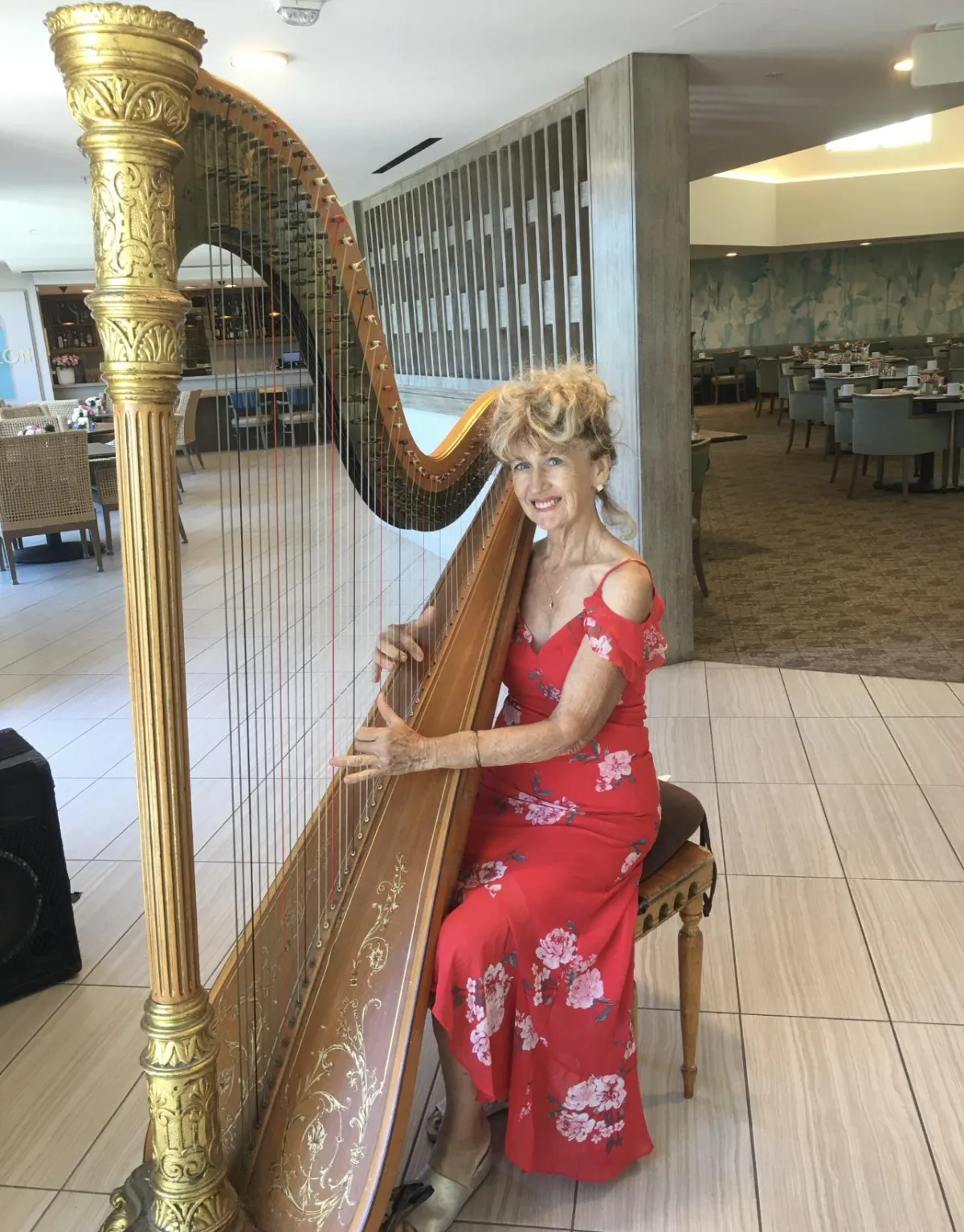
Neck
The neck of the harp is the curved or angled section at the top of the instrument, connecting the strings to the tuning mechanisms.
Structure: The neck houses the tuning pins and, on pedal harps, the complex system of discs and rods that alter pitch when the pedals are engaged. On lever harps, small levers attached to the neck can be manually raised or lowered to adjust individual string tension.
Function: The neck serves as the anchor point for the upper end of the strings. It transmits vibration to the rest of the frame while allowing precise tuning adjustments.
Engineering Considerations: Because of the immense pressure exerted by string tension (sometimes exceeding 2,000 pounds / 900 kilograms on a full concert harp), the neck must be constructed from durable hardwood or laminated materials to resist bending or cracking.
The design of the neck directly influences the harp’s ability to play in different keys and its reliability during performance.
Pillar
The pillar (also called the column) is the vertical support that connects the base of the harp to the neck, completing the triangular frame.
Structural Role: The pillar is essential for counteracting the enormous pull of the strings. Without it, the instrument’s frame would collapse under tension.
Design: On concert harps, the pillar often contains a hidden system of rods and levers connected to the pedals, transmitting movement up into the neck mechanism. This internal engineering allows harpists to change pitches seamlessly while playing.
Aesthetic Significance: Pillars are often elaborately decorated, especially on historical and orchestral harps. Carving, gilding, or inlay work may be used, making the pillar both functional and artistic.
In addition to supporting the structure, the pillar contributes to the visual grandeur of the harp, reinforcing its reputation as both a musical and decorative instrument.
Integration of Components
Together, the soundboard, neck, and pillar form the foundation of the harp’s design. The pillar provides stability, the neck secures and adjusts the strings, and the soundboard transforms string vibrations into audible sound. This triangular framework has remained remarkably consistent for centuries, although refinements in materials, mechanics, and acoustics have evolved with time.
Modern pedal harps represent the pinnacle of this engineering, combining these three essential components with sophisticated mechanisms to produce a versatile, resonant, and durable instrument.
Historical Evolution
The design of the harp’s components has evolved significantly over time:
Ancient Harps (c. 3000 BCE – 1000 CE): Early harps from Mesopotamia, Egypt, and Africa often lacked a pillar. These “bow harps” consisted of a curved neck and soundbox, with strings stretched between them. Their limited string tension produced softer sounds and fewer tonal options.
Medieval and Renaissance Harps (1000–1600 CE): The addition of the pillar in European harps stabilized the frame, allowing for more strings and greater tension. This innovation expanded the instrument’s range and volume. Soundboards were relatively flat and narrow during this period.
Baroque and Early Modern Harps (1600–1800 CE): Harps gained more elaborate neck mechanisms, including hooks and levers, which allowed limited key changes. Soundboards became broader to enhance resonance, while decorative pillars reflected the era’s ornate artistic styles.
19th Century – Pedal Harps: Sébastien Érard’s invention of the double-action pedal harp (1810) revolutionized the instrument. The pillar became a housing for intricate pedal mechanisms, and the neck incorporated disc systems for precise semitone changes. The soundboard was widened and reinforced to support higher string tension and larger ranges.
20th Century to Present: Modern harps combine centuries of design refinement. Carbon fiber reinforcements, laminated wood necks, and precision-engineered soundboards ensure durability and tonal quality. Today, the triangular structure of soundboard, neck, and pillar remains the hallmark of harp design, though materials and mechanics continue to evolve.
Strings
The strings of the harp are the primary source of its sound and define much of the instrument’s range, tone, and versatility. Modern concert harps typically feature 47 strings, while folk and lever harps may have anywhere from 22 to 40, depending on size and design. Strings are traditionally made from gut, nylon, or wire, with gut and nylon producing warm, mellow tones and wire offering brightness and resonance in the lower register. The strings are color-coded for orientation: C strings are dyed red and F strings are dyed blue or black, allowing harpists to quickly navigate the instrument’s wide range. Each string is attached at the soundboard and runs up to the neck, where it can be tuned by pins, levers, or pedal mechanisms. The tension on a modern concert harp’s strings can collectively exceed 2,000 pounds (900 kilograms), requiring the harp’s frame to be both strong and carefully engineered. Through plucking, damping, glissandi, and harmonic techniques, the strings provide a wide expressive palette that has made the harp both a solo and ensemble instrument throughout history.
The harp is a stringed musical instrument that has individual strings running at an angle to its soundboard; the strings are plucked with the fingers. Harps can be made and played in various ways, standing or sitting, and in orchestras or concerts. Its most common form is triangular in shape and made of wood. Some have multiple rows of strings and pedal attachments.
Ancient depictions of harps were recorded in Mesopotamia (now Iraq), Persia (now Iran) and Egypt, and later in India and China. By medieval times harps had spread across Europe. Harps were found across the Americas where it was a popular folk tradition in some areas. Distinct designs also emerged from the African continent. Harps have symbolic political traditions and are often used in logos, including in Ireland.
Historically, strings were made of sinew (animal tendons).[2][3] Other materials have included gut (animal intestines),[4] plant fiber,[4] braided hemp,[5] cotton cord,[6] silk,[7] nylon,[8] and wire.[9]
In pedal harp scores, double flats and double sharps should be avoided whenever possible.[10]
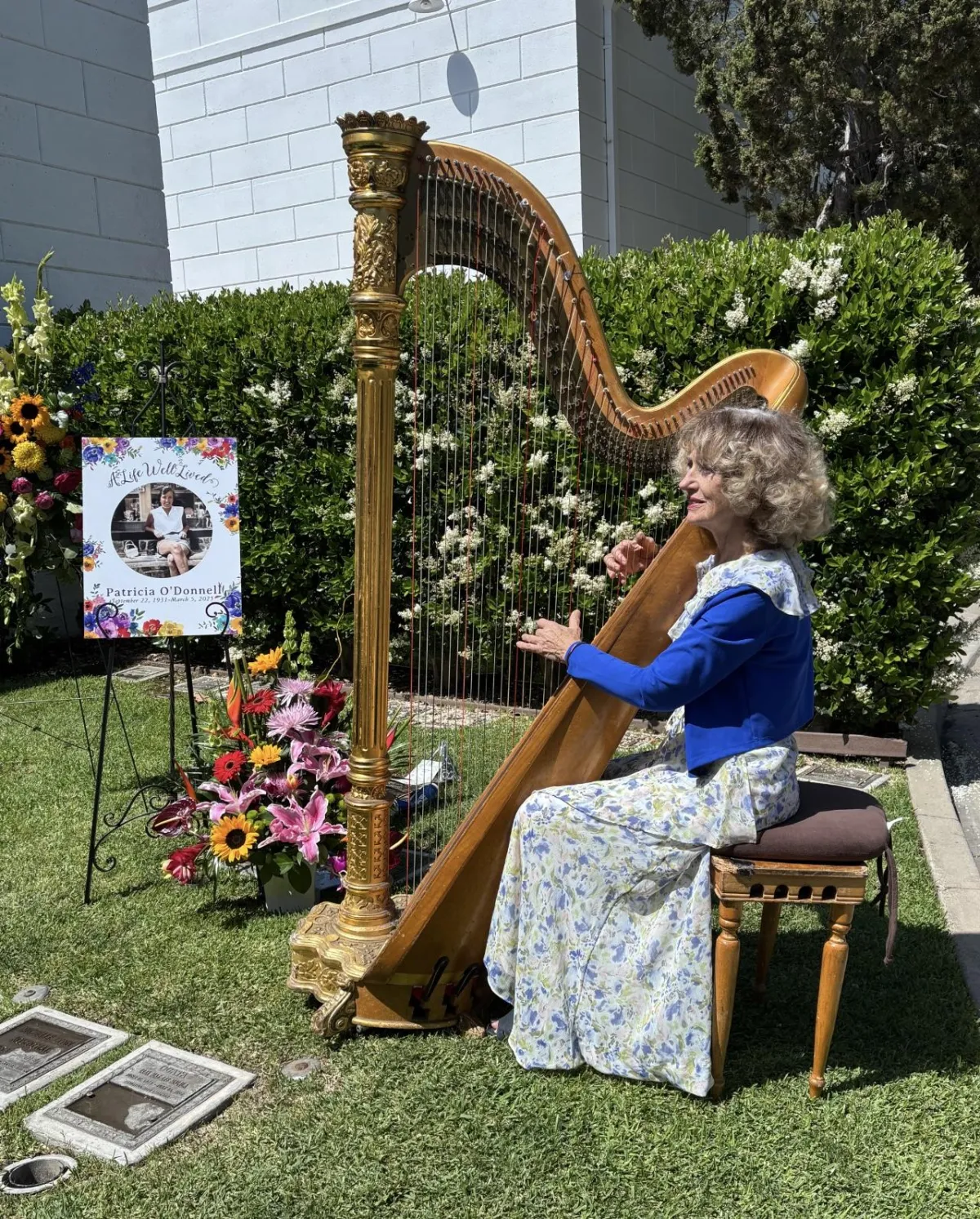
Playing Techniques
Harpists employ a wide range of techniques to produce the instrument’s distinctive sound. The most common method is plucking the strings with the fingers of both hands, which produces clear, resonant tones. The thumb and first three fingers are typically used, while the little finger is generally not engaged because of its shorter length and weaker control.
Glissando: One of the harp’s signature techniques, the glissando is created by running the fingers rapidly across a series of strings. This produces a sweeping, cascading sound often used in orchestral music and special effects.
Harmonics (Flageolet tones): By lightly touching a string at its midpoint and plucking it simultaneously, harpists can produce ethereal, bell-like sounds an octave higher than the fundamental pitch.
Damping (or muffling): Harpists frequently silence strings after plucking to control resonance and prevent unwanted overtones, allowing for clarity in complex passages.
Pres de la table: Playing close to the soundboard produces a sharper, more percussive tone, often used for dramatic effect.
Bisbigliando: Known as a “whispering effect,” this technique involves a rapid alternation of the hands on adjacent strings, creating a shimmering, tremolo-like texture.
Pedal and Lever Techniques: On pedal harps, performers use their feet to alter string tension via pedals, while lever harps use hand-operated levers. These allow chromatic changes and key shifts mid-performance.
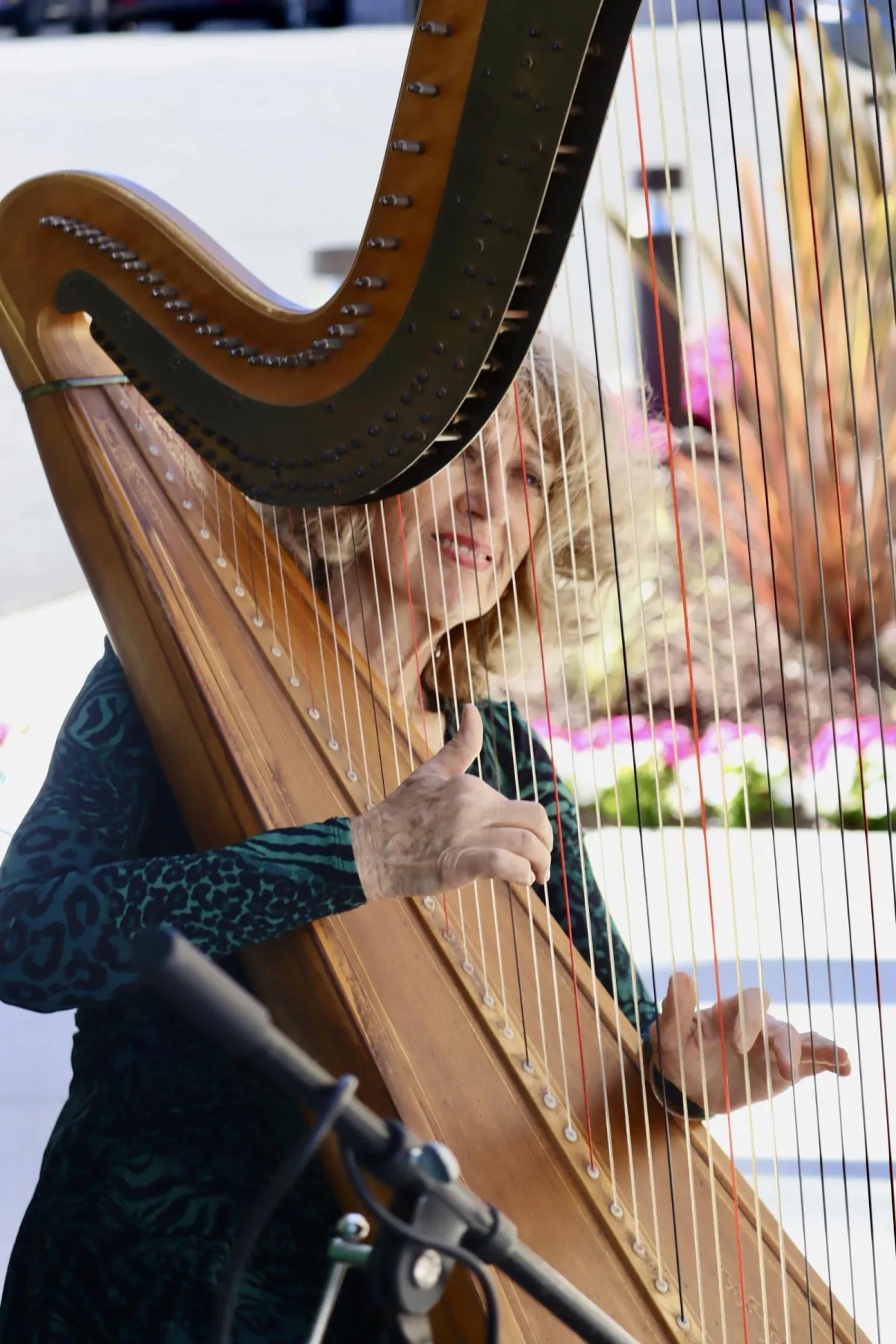
Ancient Origins
Harps are among the earliest known instruments, with evidence of harps appearing in Mesopotamia around 3000 BCE. Early Egyptian harps, often shaped like bows, lacked pillars and had a limited range. Similar instruments appeared in Africa and Asia, including the Burmese saung gauk and the African kora, which is considered a harp-lute hybrid.
Medieval and Renaissance Europe
By the Middle Ages, European harps had evolved into triangular-frame designs with a neck, pillar, and soundbox. These harps allowed for greater string tension and a wider range. The harp became central to Celtic traditions, especially in Ireland and Scotland, where it was played by bards and poets as both an instrument of entertainment and a symbol of cultural identity.
Baroque and Classical Eras
During the 17th and 18th centuries, harp makers introduced hooks and single-action pedals that allowed harpists to raise string pitch by a semitone. These developments expanded the instrument’s versatility but still limited full chromatic playing.
19th Century – The Double-Action Pedal Harp
In 1810, French instrument maker Sébastien Érard patented the double-action pedal harp, a revolutionary design that allowed each string to be raised by two semitones. This invention enabled harpists to perform in all keys with fluid pedal changes, cementing the harp’s place in orchestras and concert halls.
Modern Era
Today, the pedal harp remains the standard in classical music, while lever harps and folk harps are popular for Celtic, Latin American, and world music traditions. Advances in materials, such as carbon fiber reinforcements, have increased durability, and electric harps have expanded the instrument into jazz, pop, and experimental genres.
A croissant is a French Viennoiserie in a crescent shape made from a laminated yeast dough that sits between a bread and a puff pastry.
It is a buttery, flaky, Viennoiserie inspired by the shape of the Austrian kipferl, but using the French yeast-leavened laminated dough. Croissants are named for their historical crescent shape. The dough is layered with butter, rolled and folded several times in succession, then rolled into a thin sheet, in a technique called laminating. The process results in a layered, flaky texture, similar to a puff pastry.
Crescent-shaped breads have been made since the Renaissance, and crescent-shaped cakes possibly since antiquity. The modern croissant was developed in the early 20th century, when French bakers replaced the brioche dough of the kipferl with a yeast-leavened laminated dough.
In the late 1970s, the development of factory-made, frozen, preformed but unbaked dough made them into a fast food that could be freshly baked by unskilled labor. The croissant bakery, notably the La Croissanterie chain, was a French response to American-style fast food, and as of 2008, 30–40% of the croissants sold in French bakeries and patisseries were baked from frozen dough.
Croissants are a common part of a continental breakfast in many European countries.
Use in Events and Ceremonies
The harp is frequently employed in a variety of formal and informal events due to its distinctive sound and visual elegance. Its versatility allows it to serve both as a solo instrument and as part of ensembles, making it popular across cultural, social, and ceremonial settings.
Weddings: The harp is commonly chosen for wedding ceremonies and receptions, where it is used to perform processional and recessional music as well as background pieces during dining. Its association with romance and elegance has made it a traditional favorite for such occasions.
Religious Services: Harps are used in churches, temples, and other places of worship. They are often incorporated into liturgical music, hymn accompaniments, or meditative settings, reflecting the instrument’s long-standing association with spirituality.
Funerals and Memorials: The harp’s gentle and contemplative tone is considered appropriate for solemn occasions, offering comfort and reflection.
Corporate and Private Events: The instrument is frequently featured at galas, banquets, exhibitions, and private gatherings to provide ambient background music.
Concerts and Festivals: Both pedal and folk harps are presented in solo recitals, chamber ensembles, and orchestral performances. In cultural festivals, regional harps such as the Paraguayan harp or Celtic harp are featured prominently in traditional music.
Public and Civic Ceremonies: Harpists may perform at inaugurations, award ceremonies, or diplomatic functions, where the instrument adds formality and distinction.
The harp’s ability to adapt to different musical styles—from classical to contemporary—ensures its continued presence in a wide range of public and private events around the world.
A farmers’ market is a physical retail space where agricultural producers, artisans, and small-scale vendors sell directly to consumers. Typically held in open-air settings such as town squares, parks, or community centers, farmers’ markets provide access to fresh, locally produced foods and goods while fostering connections between growers and the public. They have become significant components of local food systems, supporting regional agriculture, sustainable practices, and community interaction.
A gold harp is a decorative or ceremonial variation of the harp in which the instrument, often a concert pedal harp, is finished with gold leaf, gilding, or metallic paint. While musically identical to standard harps, gold harps are valued for their visual grandeur and symbolic associations with prestige, elegance, and luxury.
Design and Construction
Gold harps are typically built on the same framework as traditional pedal harps. The structural materials, such as maple or spruce, remain unchanged, but the exterior surfaces—particularly the pillar, neck, and base—are coated with gold leaf or metallic finishes. In some cases, intricate carvings are highlighted with gilding, further emphasizing craftsmanship. Well-known harp makers, including Lyon & Healy and Salvi Harps, produce gold-finished concert harps as part of their premium collections.
Pedal System
The pedal harp, which became standard in the 19th century, uses a system of seven pedals to enable chromatic playing. Each pedal corresponds to one of the seven pitch classes: C, D, E, F, G, A, and B. By shifting a pedal into three positions—flat, natural, or sharp—a harpist can raise or lower all strings of that note across the instrument by one or two semitones. This mechanism is achieved through an intricate linkage of rods running inside the pillar and into the neck, where rotating discs shorten or lengthen the vibrating portion of the string.
The development of the double-action pedal system by Sébastien Érard in 1810 revolutionized the harp, making it possible to play in any key and allowing for seamless modulation. This innovation secured the harp’s place in symphony orchestras and expanded its solo repertoire, as composers could now write music that fully utilized chromatic harmony.
Levers
On smaller folk and Celtic harps, semitone adjustments are made with levers attached to individual strings. Unlike the foot pedals of the concert harp, levers are operated by hand. When engaged, a lever presses against the string, effectively shortening its vibrating length and raising its pitch by a semitone. While this system lacks the full chromatic flexibility of the pedal harp, it offers simplicity and portability, making lever harps popular for traditional and folk music. Lever harps are also favored by beginners due to their accessibility and lower cost compared to concert pedal harps.
Soundboards
The soundboard is a critical component of the harp, responsible for amplifying the vibrations of the strings. Concert harps typically feature broad, reinforced spruce soundboards, designed to project a rich, resonant tone in large performance spaces. Their size and shape enhance the harp’s lower register and sustain, making them ideal for orchestral use.
Folk and lever harps, by contrast, often use smaller and lighter soundboards, producing a brighter and more intimate sound suited for traditional settings or smaller venues. The dimensions and curvature of the soundboard significantly influence the instrument’s timbre, with wider boards yielding a warmer tone and narrower boards creating sharper resonance.
Materials
The choice of materials in harp construction affects both sound and durability. Maple is commonly used for the frame and pillar due to its strength, while spruce is the traditional material for soundboards because of its resonant qualities. Strings are made from gut, nylon, or wire: gut strings provide warmth and complexity, nylon offers brightness and durability, and wire-wound strings add depth in the bass register.
In recent decades, modern innovations such as carbon-fiber harps have emerged, offering lightweight alternatives that resist humidity and temperature fluctuations. These instruments are particularly valued by traveling musicians and those performing in varied climates. Decorative features—including gilding, carving, and inlay—are also common, especially on concert harps, emphasizing the dual role of the instrument as both a functional and visual work of art.
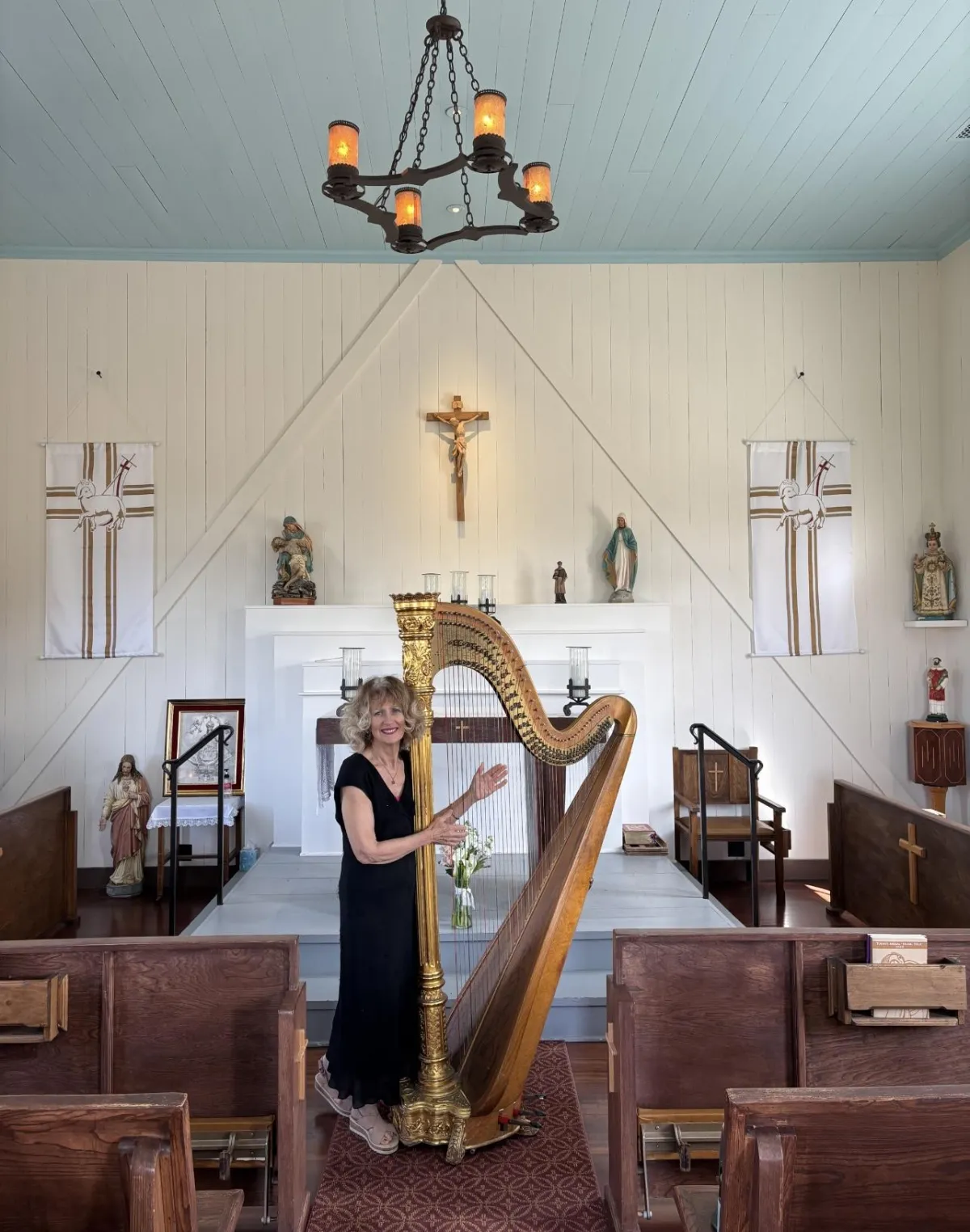
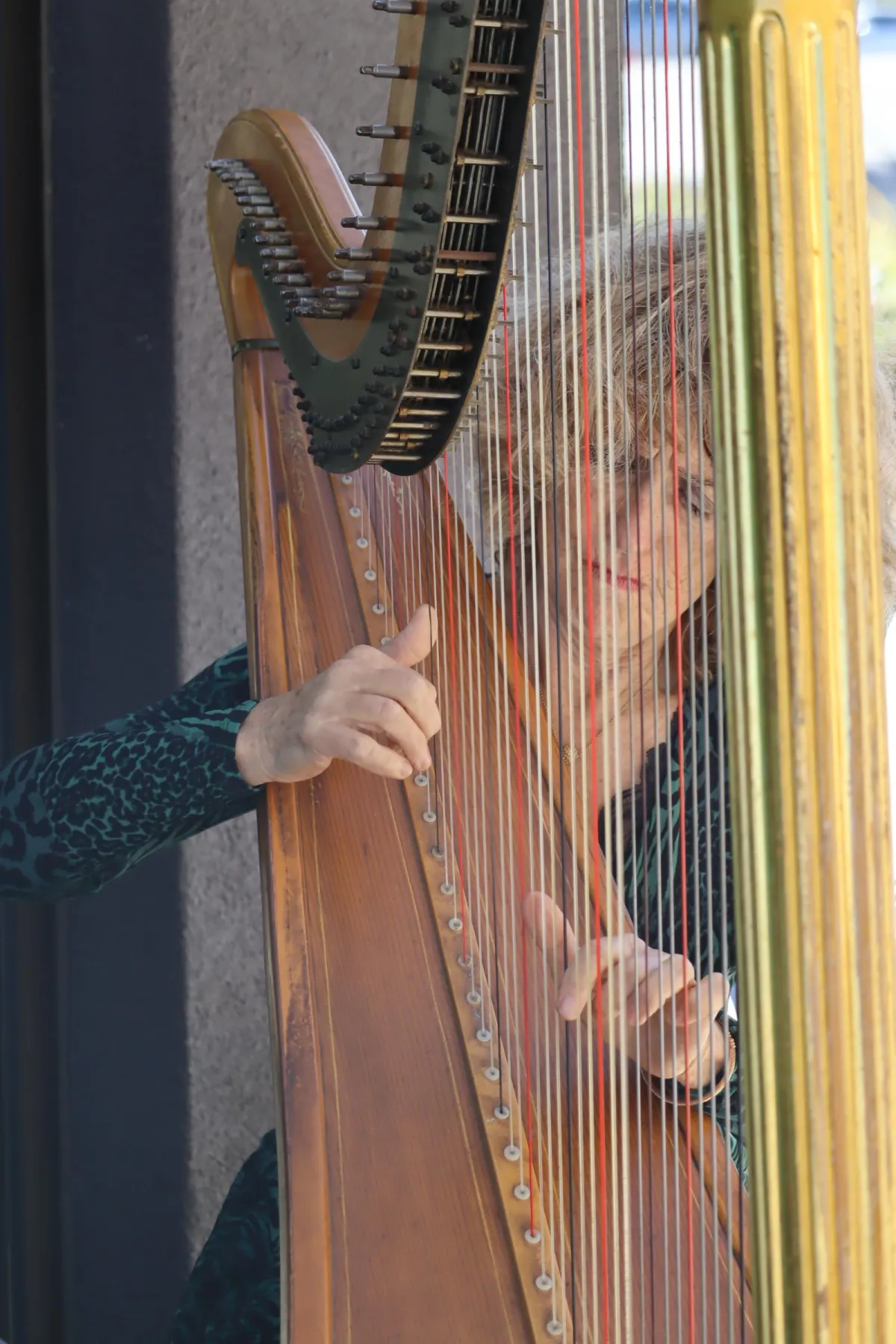
Ireland
The harp is one of the most prominent national emblems of Ireland, and its presence in Irish identity dates back to the Middle Ages. By the 13th century, harpers were regarded as highly respected members of society, serving as court musicians, storytellers, and chroniclers. The instrument came to symbolize sovereignty, unity, and resistance to oppression. During periods of English rule, the harp was even suppressed due to its powerful cultural associations.
In modern times, the harp remains central to Irish iconography. It appears on the coat of arms of Ireland, on official government seals, and on national currency. One of the most widely recognized commercial uses of the symbol is the Guinness logo, which has featured a stylized harp since the 19th century. The Irish harp is also celebrated in traditional and folk music, where it is played on smaller Celtic harps or cláirseach, continuing a lineage that connects modern performance to medieval traditions.
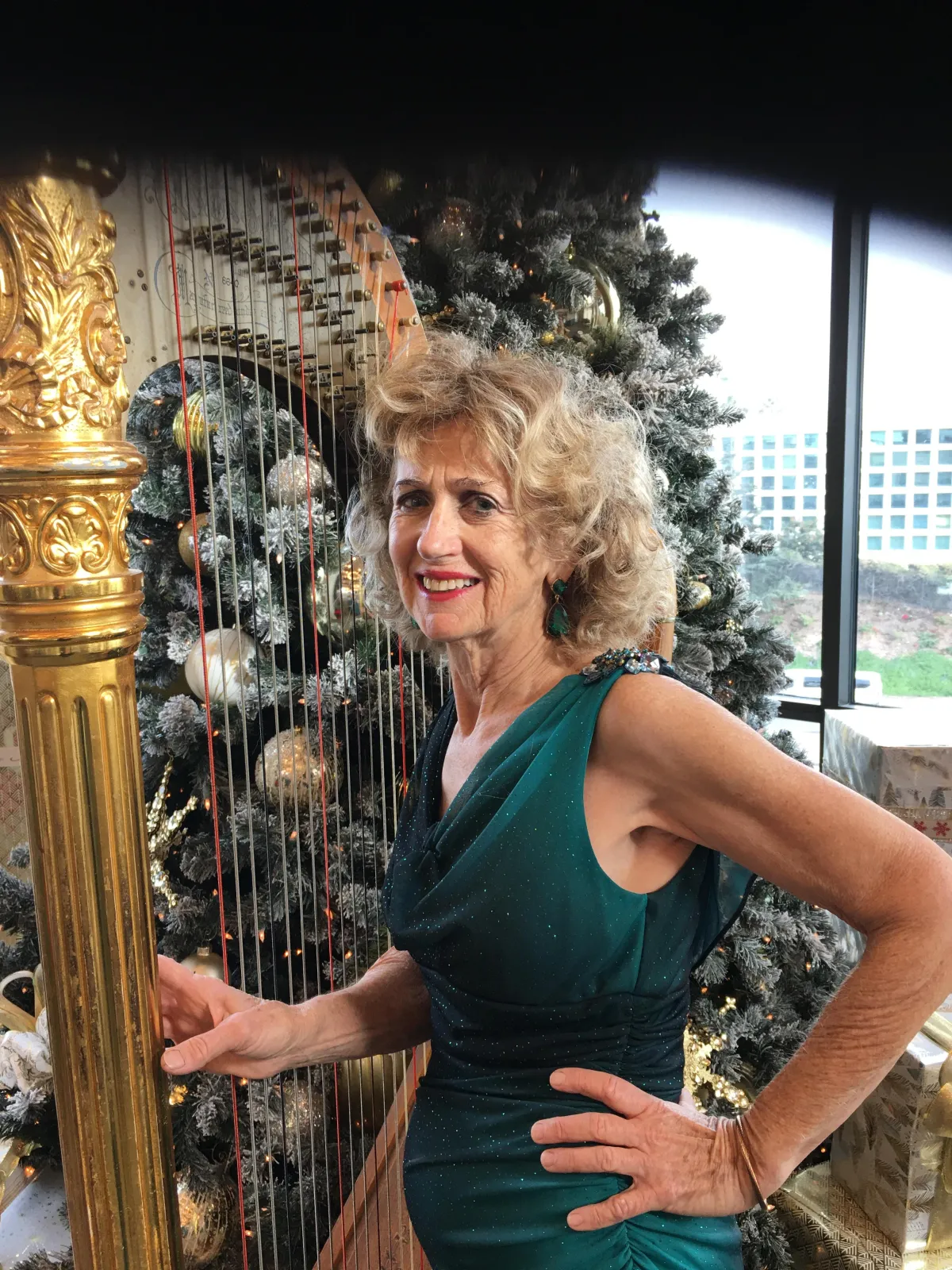
Musical Characteristics
The harp is one of the few instruments capable of producing both melody and harmony simultaneously, giving it a role similar to that of the piano in terms of self-sufficiency. Modern concert harps typically contain 47 strings, spanning a range of more than six octaves, from the lowest C to the highest G. Smaller folk and lever harps may contain between 22 and 40 strings, with a correspondingly narrower range.
The tension of the strings is a defining feature of the instrument. On a full-size pedal harp, the collective tension exerted on the frame can exceed 900 kilograms (approximately 2,000 pounds). This immense pressure requires careful engineering, particularly in the neck and pillar, to prevent structural failure while maintaining tonal clarity.
Harp strings are made from a variety of materials, most commonly gut, nylon, and wire. Each material contributes a distinct tonal quality: gut strings provide a warm, mellow sound; nylon offers durability and brightness; and wire-wound strings add resonance and depth to the lower register. To aid navigation, the strings are color-coded: C strings are dyed red, while F strings are blue or black, helping harpists orient themselves across the instrument’s wide range.
The harp’s sound is frequently described as ethereal, shimmering, and resonant. Its versatility allows it to produce a wide dynamic range, from delicate, barely audible tones to powerful, sweeping arpeggios. Unlike many other string instruments, the harp’s design enables performers to create characteristic techniques such as glissandi (rapid sweeps across strings) and harmonics (producing bell-like tones by lightly touching the midpoint of a string while plucking).
While traditionally associated with classical and folk music, the harp’s musical characteristics have enabled its incorporation into diverse genres, including jazz, pop, and film music. The development of the electric harp has further expanded its musical possibilities, allowing performers to integrate amplification, electronic effects, and modern soundscapes into their performances.
Cultural Significance
The harp holds an important place in the cultural identity of many nations and societies, where it functions not only as a musical instrument but also as a symbol of heritage, spirituality, and artistic tradition. Its enduring association with refinement and transcendence has made it one of the most recognizable and culturally significant instruments in the world.
Paraguay
The Paraguayan harp is considered the national instrument of Paraguay and plays a vital role in the country’s cultural and musical life. Introduced by Spanish missionaries in the 16th century, the harp was adapted over time by local musicians to develop a distinct regional style. Paraguayan harps are typically lighter in construction, with a bright, resonant tone that lends itself to rapid and rhythmic playing.
In Paraguayan folk music, the harp often leads ensembles and is central to traditional dances and ceremonies. The instrument is associated with national pride, and its music is widely recognized across South America. Festivals and competitions dedicated to Paraguayan harp music continue to celebrate its role as both a national symbol and a cornerstone of regional identity.
West Africa
In West Africa, a related instrument called the kora is deeply embedded in the traditions of the griots, or hereditary storytellers and musicians. While technically classified as a harp-lute hybrid, the kora shares many structural and cultural similarities with harps. It typically has 21 strings and is constructed from a calabash resonator covered with cowhide.
The kora is more than a musical instrument; it is a tool for oral history and cultural continuity. Griots use it to accompany songs that recount genealogies, historical events, and moral lessons, preserving collective memory across generations. In countries such as Senegal, Mali, and The Gambia, the kora symbolizes both musical artistry and the social function of storytelling.
Mythology and Religion
The harp has long-standing associations with mythology and religion, where it is frequently connected to themes of divinity and transcendence. In biblical tradition, the figure of King David is depicted playing a harp to soothe King Saul, establishing its role as an instrument of sacred and emotional power. In Christian iconography, harps are commonly shown in the hands of angels, symbolizing heavenly harmony and eternal peace.
In Celtic mythology, the harp was believed to possess magical qualities, capable of evoking joy, sorrow, or sleep depending on how it was played. This mythology reinforced its symbolic role as an instrument of emotional transformation and spiritual resonance. Across cultures, the harp has been used to bridge the human and divine, appearing in ceremonies, rituals, and artistic depictions of transcendence.
Broader Symbolism
Beyond specific national and religious contexts, the harp has become a universal symbol of elegance, peace, and cultural refinement. Its image is frequently used in literature, visual art, and media to represent purity and harmony. In modern commercial branding, the harp continues to function as an emblem of tradition, sophistication, and timeless beauty.
Career
Margaret Klemm performs throughout Southern California, particularly in Orange County and Los Angeles County. She is frequently engaged for a wide variety of occasions:
Weddings and Ceremonies – Performing traditional processional and recessional music as well as customized selections.
Private and Corporate Events – Providing background and feature performances for receptions, galas, and celebrations.
Concert and Solo Work – Presenting programs that include classical, folk, and contemporary selections.
Her repertoire spans Baroque and Romantic works, impressionist music by composers such as Debussy and Ravel, adaptations of jazz standards, and arrangements of popular songs. This stylistic breadth allows her to tailor performances to the atmosphere of each event.
Musical Style and Repertoire
Klemm is known for combining classical artistry with modern versatility. Her performances frequently feature techniques such as glissandi, harmonics, and bisbigliando to highlight the harp’s expressive qualities. She adapts her programs for both intimate gatherings and large venues, emphasizing the harp’s ability to provide ambiance while also commanding attention as a solo instrument.
Instrument
Margret Klemm primarily performs on a concert pedal harp, which allows chromatic modulation across all keys. For smaller or folk-inspired settings, she also uses lever harps, reflecting her adaptability across genres. Her choice of instruments emphasizes both traditional craftsmanship and modern design.
Community Engagement
Based in San Clemente, Klemm draws inspiration from the coastal landscape of Southern California. She collaborates with local venues, planners, and cultural organizations, seeking to bring live harp music to a wider audience. In addition to performances, she is an advocate for making harp music accessible at community events, educational programs, and wellness settings.
Therapeutic Use
The harp has been increasingly employed in therapeutic contexts, where its distinctive tonal qualities are considered conducive to relaxation, healing, and emotional well-being. Harp therapy refers to the structured use of live harp music in healthcare settings such as hospitals, hospices, and wellness centers. Practitioners often perform at the bedside of patients, tailoring tempo, dynamics, and repertoire to match the individual’s breathing patterns, emotional state, or level of pain. The harp’s resonance and wide harmonic range allow it to produce soothing overtones, which some studies suggest can reduce stress, lower blood pressure, and alleviate anxiety. In palliative care, harp music has been used to comfort terminally ill patients, creating an atmosphere of peace and dignity during end-of-life care. The practice is distinct from music therapy, which is a clinical discipline, though harp therapy is frequently employed as a complementary approach to support physical and emotional health.
In addition to clinical use, harp therapy programs have been established to train musicians in techniques specifically designed for therapeutic environments. Professional organizations, such as the International Harp Therapy Program (IHTP), provide certification in this field, emphasizing patient-centered approaches and the adaptability of harp performance to non-concert settings. Research on therapeutic harp music has also explored its potential benefits for premature infants in neonatal intensive care units, where gentle live playing may stabilize heart rates and encourage weight gain. In rehabilitation, harp therapy is sometimes used to promote relaxation in patients recovering from surgery or coping with chronic illness. The use of the harp in hospitals and wellness contexts highlights the instrument’s enduring association with tranquility, spirituality, and healing, reinforcing its cultural identity as not only an artistic instrument but also a tool for human well-being.
Old Town San Clemente Market
Local. Handmade. Heartfelt. Join us for a community-driven farmer's market in the heart of San Clemente.

